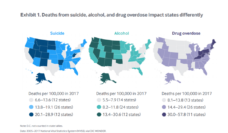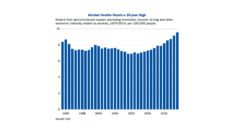Areas with higher concentrations of stores that sell alcohol–alcohol outlets–have higher levels of violence. But what are the features of alcohol outlets that contribute to the association with violence? Identifying specific outlet characteristics connected with neighborhood violence may point to more feasible alternatives for making environments safer. In our recent work, we identified one such feature: alcohol ads. Alcohol outlets in Baltimore, MD that hung alcohol ads so they were visible from the street had higher levels of violent crime within 1,000 feet.
We found that publicly visible alcohol ads were associated with 30% higher levels of homicide and 15% higher levels of aggravated assault, forcible rape, and robbery. In Baltimore, this translated to roughly three additional violent crimes within 1,000 feet of the outlets each year on average.
We considered and tested alternate explanations for our findings, starting with one of the most common: the “neighborhood hypothesis.” This hypothesis argues that associations between alcohol outlets and violence arise not from the outlets themselves but rather from the neighborhoods where the outlets are located. To test this, we measured neighborhood contexts known to be strong correlates of violence and alcohol outlets, including drug arrests, racial/ethnic composition, income level, and social disadvantage. The associations between the ads and violence remained.
Next, we tested whether neighborhoods (census tracts) with outlets and ads had different levels of violent crime from other neighborhoods. We compared three types of neighborhoods: those that only contained alcohol outlets with ads; those that contained only alcohol outlets with no ads; and those that contained alcohol outlets both with and without ads. After accounting for the number of people who lived in each type of neighborhood, there were no differences in the levels of violent crime in these three types of neighborhoods.
Alcohol outlets in Baltimore, MD that hung alcohol ads so they were visible from the street had higher levels of violent crime within 1,000 feet.
We also tested whether our findings could result from some factor not specific to the alcohol shown in the ads. Thus, we compared alcohol outlets with tobacco ads visible from the street to those without such tobacco ads and found no association between the tobacco ads and violence. This suggested that the association was specific to the alcohol content of the ads.
We offer three potential hypotheses for why publicly visible alcohol ads may be associated with violence. First, ads may increase alcohol consumption by normalizing alcohol consumption and increasing the appeal of the places that sell it. Alcohol consumption is a risk factor for violence perpetration and victimization. Second, ads may promote price discounts, which tend to appeal to a younger, more violence-prone audience. Third, the ads may use provocative imagery to target this same audience at higher risk of engaging in violence. This is consistent with previous research linking outlets with alcohol ads that sexualize Latinas with more violence against women near those outlets.
We encourage future exploration into the potential association between alcohol ads and harms associated with alcohol outlets, especially through the use of the natural experiments. These natural experiments should be used when jurisdictions remove alcohol ads outside alcohol outlets, making it possible for researchers to directly compare time periods when there were ads to times when there were no ads. Numerous jurisdictions have placed limits on signage visible from the street, but these limits are often not enforced. Other jurisdictions may have the power to do this but have not exercised it. Our research suggests that setting and enforcing these limits may have life-saving potential.
Photo by Taylor Rooney on Unsplash















